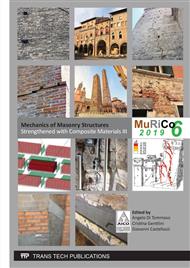[1]
Monaco, A., Minafò, G., Cucchiara, C., D'Anna, J., & La Mendola, L. (2017). Finite element analysis of the out-of-plane behavior of FRP strengthened masonry panels. Composites Part B: Engineering, 115, 188-202.
DOI: 10.1016/j.compositesb.2016.10.016
Google Scholar
[2]
Binda, L., Fontana, A., & Anti, L. (1991). Load transfer in multiple leaf masonry walls. Proc. In: Brick and Block Masonry, 3, 1488-1497.
Google Scholar
[3]
Micelli, F., Cascardi, A., & Marsano, M. (2016, June). Seismic strengthening of a theatre masonry building by using active FRP wires. In Brick and Block Masonry: Proceedings of the 16th International Brick and Block Masonry Conference (pp.753-761).
DOI: 10.1201/b21889-94
Google Scholar
[4]
Foti, D., Lerna, M., & Vacca, V. (2018). Experimental Characterization of Traditional Mortars and Polyurethane Foams in Masonry Wall. Adv. in Mat. Sci. and Eng, (2018).
DOI: 10.1155/2018/8640351
Google Scholar
[5]
Corradi M., Borri A., Poverello E. Castori G. (2017) The use of transverse connectors as reinforcement of multi-leaf walls, Materials and Structures (2017) 50:114.
DOI: 10.1617/s11527-016-0977-3
Google Scholar
[6]
Minafo, G., Cucchiara, C., Monaco, A., & La Mendola, L. (2017). Effect of FRP strengthening on the flexural behaviour of calcarenite masonry walls. Bulletin of Earthquake Engineering, 15(9), 3777-3795.
DOI: 10.1007/s10518-017-0112-z
Google Scholar
[7]
Marcari, G., Fabbrocino, G., & Manfredi, G. (2007). Shear seismic capacity of tuff masonry panels in heritage constructions. Structural Studies, Repairs and Maintenance of Heritage Architecture X, 95, 73.
DOI: 10.2495/str070081
Google Scholar
[8]
Bozzano, C., Podestà, S., Scandolo, L., & Brignola, A. (2013). Prove di compressione diagonale su murature a due paramenti: l'influenza dei diatoni. In Proceedings of 15th Italian conference, ANIDIS, Padova. [In Italian].
Google Scholar
[9]
Corradi, M., Borri, A., & Vignoli, A. (2008). Experimental evaluation of in-plane shear behaviour of masonry walls retrofitted using conventional and innovative methods. In: Masonry International, 21(1), 29.
Google Scholar
[10]
Gattesco, N., Amadio, C., & Bedon, C. (2015). Experimental and numerical study on the shear behavior of stone masonry walls strengthened with GFRP reinforced mortar coating and steel-cord reinforced repointing. Engineering Structures, 90, 143-157.
DOI: 10.1016/j.engstruct.2015.02.024
Google Scholar
[11]
Candela, M., Borri, A., Corradi, M., & Righetti, L. (2016). Effect of transversal steel connectors on the behaviour of rubble stone-masonry walls: two case studies in Italy. Brick and Block Masonry – Trends, Innovations and Challenges – Modena, da Porto & Valluzzi (Eds). Taylor & Francis Group, London, ISBN 978-1-138-02999-6.
DOI: 10.1201/b21889-252
Google Scholar
[12]
Monni, F., Quagliarini, E., & Lenci, S. (2017). Basalt fibre continuous stitchings for strengthening the dry-stone masonry of the Lossetti Tower in Beura-Cardezza (Italy). Tema: Technology, Engineering, Materials and Architecture, 3(1), 137-148.
DOI: 10.30682/tema0301m
Google Scholar
[13]
Corradi, M., Borri, A., Poverello, E., & Castori, G. (2017). The use of transverse connectors as reinforcement of multi-leaf walls. Materials and Structures, 50(2), 114.
DOI: 10.1617/s11527-016-0977-3
Google Scholar
[14]
Anania, L., & Badalà, A. (2017). The Use of Carbon Fiber Cementitious Matrix Connection for the Strenghtening of Multiple-Leaves Masonry. In Key Engineering Materials (Vol. 747, pp.366-373). Trans Tech Publications.
DOI: 10.4028/www.scientific.net/kem.747.366
Google Scholar
[15]
Cascardi, A., Micelli, F., & Aiello, M. A. (2016). Analytical model based on artificial neural network for masonry shear walls strengthened with FRM systems. Composites Part B: Engineering, 95, 252-263.
DOI: 10.1016/j.compositesb.2016.03.066
Google Scholar
[16]
DI UNIFICAZIONE, E. N. I. (2001). Metodi di prova per malte per opere murarie-Determinazione della resistenza a flessione ea compressione della malta indurita. UNI, Milan, Italy, 1015-11 [In Italian].
Google Scholar
[17]
UNI, E. (2007). Metodi di prova per pietre naturali–Determinazione della resistenza a compressione uniassiale [In Italian].
Google Scholar
[18]
UNI, E. (2001). 1052-1. Metodi di prova per muratura - Determinazione della resistenza a compressione [In Italian].
Google Scholar
[19]
ASTM. (2002c). Standard test method for diagonal tension (shear) in masonry assemblages., ASTM E519-02, West Conshohocken, PA.
Google Scholar


